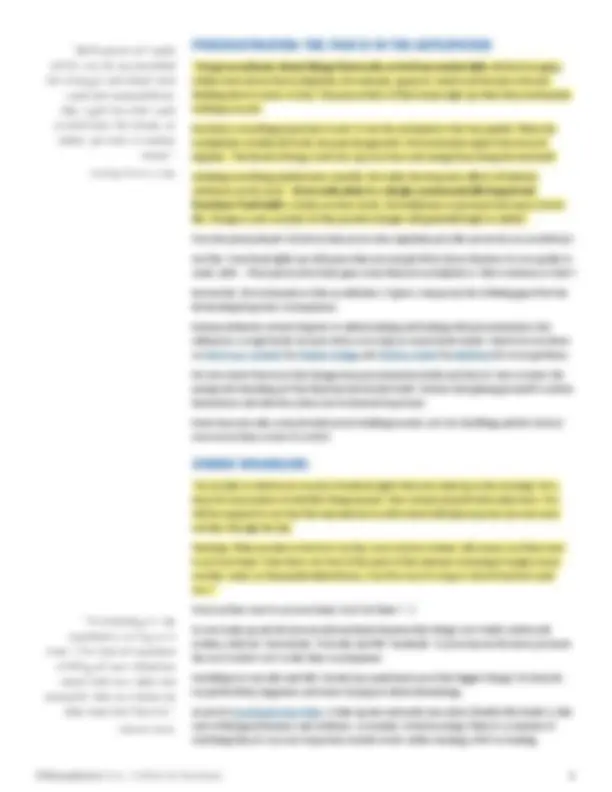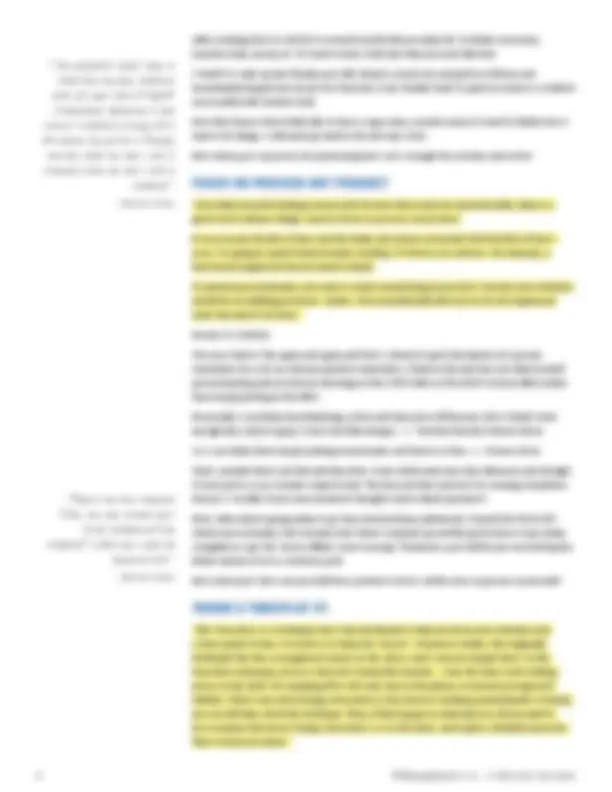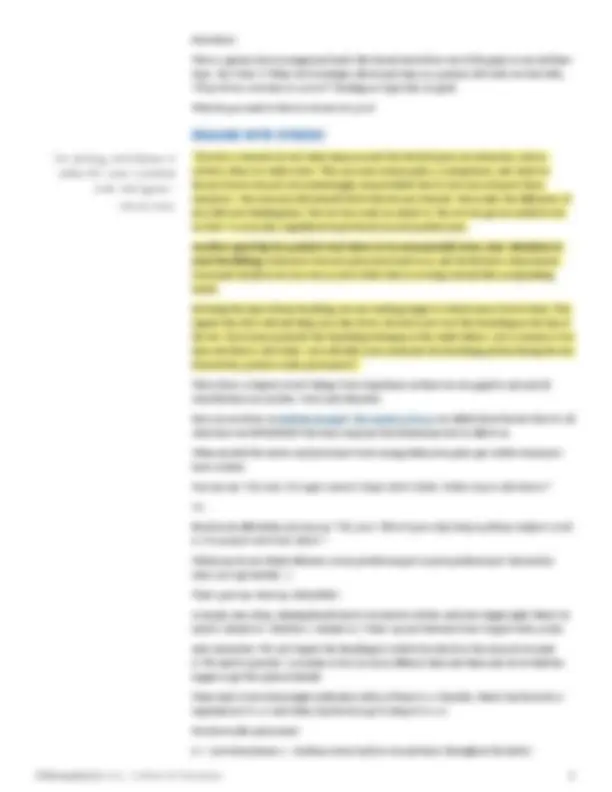





Study with the several resources on Docsity

Earn points by helping other students or get them with a premium plan


Prepare for your exams
Study with the several resources on Docsity

Earn points to download
Earn points by helping other students or get them with a premium plan
Community
Ask the community for help and clear up your study doubts
Discover the best universities in your country according to Docsity users
Free resources
Download our free guides on studying techniques, anxiety management strategies, and thesis advice from Docsity tutors
How to learn more effectively using strategies that can help you learn.
Typology: Summaries
1 / 6

This page cannot be seen from the preview
Don't miss anything!




TM
More Wisdom in Less Time
~ Barbara Oakley, Ph.D. from A Mind for Numbers I got this book after reading So Good They Can’t Ignore You by Cal Newport (see Notes). Although, as per the sub-title, the book is ostensibly about “How to Excel at Math and Science (Even If You Flunked Algebra),” it’s really about excelling at learning and at LIFE! Barbara Oakley is an award-winning engineering teacher who used to struggle mightily with math and science. She walks us through the latest research in neuroscience and learning as she shares fascinating biographical sketches of scientific + mathematical luminaries along with wisdom from other world-class teachers. If you’re passionate about learning how to learn, I think you’ll love it. If you’re a student looking to master your work, I think you’ll love it. If you’re a parent with a child who’s struggling in school I think you’ll love it. (Get the book here.) It’s packed with Big Ideas. I’m excited to share some of favorites so let’s jump straight in!
“One way to think of the diffuse mode is as a base station when you are mountain climbing. Base stations are essential resting spots in the long journey to difficult mountaintops. You use them to pause, reflect, check your gear, and make sure you’ve got the right route picked out. But you would never confuse resting at a base station with the hard work of getting to the top of the mountain. In other words, just using your diffuse mode doesn’t mean you can lollygag around and expect to get anywhere. As the days and weeks pass, it’s the distributed practice—the back and forth between focused-mode attention and diffuse-mode relaxation—that does the trick.”
How to Excel at Math and Science (Even If You Flunked Algebra) BY BARBARA OAKLEY, PH.D. · TARCHER © 2014 · 336 PAGES
Focused vs. Diffused.
Working —> long-term memory.
Pain is in the anticipation.
Work then reward.
What to do vs. results.
Throw some at it!
Remember: “I’m excited!”
Want to learn? Teach. “When you follow these concrete tips based on how we actually learn, you’ll be amazed to see the changes within yourself, changes that can allow new passions to bloom.” ~ Barbara Oakley
Focused mode vs. diffuse mode. We need ‘em both. Herbert Benson wrote a whole book on this called The Breakout Principle (see Notes). And, Jim Loehr describes something similar as “training our recovery.” He tells us we need to “make waves” between intense effort and equally intense recovery. Focused mode is pretty straight-forward: Put in the effort! Think: The hard work of mountain climbing. Diffused mode includes things like workout out, going for a hike, taking a nap, getting a massage, meditating, taking a bath/shower and the ultimate diffuse mode: SLEEPING! Think: The basecamps where we recover. Magical things happen when we turn our conscious minds off and let our subconscious minds go to work. As Heidi Grant Halvorson tells us in Succeed (see Notes), “Metaphorically speaking, if your unconscious mind can hold information equivalent to a NASA supercomputer, your conscious mind can hold roughly the contents of a Post-it note.” <— We want to put that supercomputer to work. How’s your focus? And how’s your diffusing? What are you doing well in each and how can you dial each in?! THE JUGGLER & THE STORAGE FACILITY “ Working memory is the part of memory that has to do with what you are immediately and consciously processing in your mind. It used to be thought that our working memory could hold around seven items, or ‘chunks’ but it’s now widely believed that the working memory holds only about four chunks of information... You can think of working memory as the mental equivalent of a juggler. The four items stay in the air—or in working memory—because you keep adding a little energy... In contrast, long-term memory might be thought of as a storage warehouse. Once items are in there, they generally stay put. The warehouse is large, with room for billions of items, and it can be easy for stored parcels to get buried so deeply that it’s difficult to retrieve them. Research has shown that when your brain first puts an item of information in long-term memory, you need to revisit it a few times to increase the chances you’ll later be able to find it when you need it.” I love this. Our memory has two primary components: working memory and long-term memory. Think of working memory as a juggler keeping the stuff you’re “working on” understanding in the air. As we more and more deeply understand the content we’re working on, the juggler tosses the balls/memory ”chunks” into a big ol’ storage warehouse that is our long-term memory. Then we need to keep the warehouse nice and organized by coming back to the information a few times after learning it—which is called “spaced repetition.” I read this book excited about finding Ideas to help me optimize both my learning AND my teaching. I was particularly moved by this Idea of simplifying, chunking and spacing repetitions so we can lock these Big Ideas firmly in our minds and lives as this is precisely what I aspire to do with these Notes + Micro Classes. A couple other quick tips on improving your learning: Use recall: After reading a Note or watching a Micro Class, look away and recall the essence of the Idea (and think about how you can apply it!). Be excited to revisit an Idea from a different angle knowing that the spaced repetition is helping you program the wisdom (juggler —> warehouse). “Research has shown this helps your subconscious to grapple with the tasks on the list so you figure out how to accomplish them. Writing the [task] list before you go to sleep enlists your zombies to help you accomplish the items on the list the next day.” ~ Barbara Oakley “It’s important to transform distant deadlines into daily ones. Attack them bit by bit. Big tasks need to be translated into smaller ones that show up on your daily task list. The only way to walk a journey of a thousand miles is to take one step at a time.” ~ Barbara Oakley
After crushing that I’m GIDDY to reward myself with an online hit. YouTube comments, member chats, email, etc. It’s hard to have a bad day when you start like that. I used to wake up late (thanks poor PM rituals!), reach over and grab my iPhone and immediately hopped into email. Post that jolt, it was really hard to quiet my mind so I could do some really solid creative work. Now that I know what it feels like to have a super clear, creative mind, it’s hard to believe how I used to do things. I will never go back to the old ways. Ever. How about you? Any room for optimizing here? Let’s wrangle the zombies and rock it! FOCUS ON PROCESS NOT PRODUCT “If you find yourself avoiding certain tasks because they make you uncomfortable, there is a great way to reframe things: Learn to focus on process , not product. Process means the flow of time and the habits and actions associated with that flow of time— as in, ‘I’m going to spend twenty minutes working.’ Product is an outcome—for example, a homework assignment that you need to finish. To prevent procrastination, you want to avoid concentrating on product. Instead, your attention should be on building processes—habits—that coincidentally allow you to do the unpleasant tasks that need to be done.” Process vs. Product. We come back to this again and again and that’s a REALLY good description of a process orientation vis-a-vis an outcome/product orientation. Check in the next time you find yourself procrastinating and see if you’re focusing on the OUTCOME or PRODUCT of your effort rather than simply putting in the effort. Personally, I can think about finishing a Note and then put it off because I don’t think I have enough time and/or (gasp!) I don’t feel like doing it. <— Product/Result/Outcome focus. Or, I can think about simply putting in xx minutes and leave it at that. <— Process focus. That’s actually what I just did with this Note. I had a little extra time this afternoon and thought I’d just put in 20-30 minutes of good work. The time just flew and now I’m nearing completion. Process! I wouldn’t have even started if I thought I had to finish (product!). Note: After almost going online to go buy a book Barbara referenced, I turned the Wi-Fi off— which came in handy a few minutes later when I conjured up another good reason to go online. I laughed as I got the “you’re offline” error message. Thank you, past self for pre-committing the future version of us to a virtuous path! How about you? How can you shift from product to focus a little more on process in your life? THROW A TOMATO AT IT! “The ‘Pomodoro’ is a technique that’s been developed to help you focus your attention over a short period of time. Pomodoro is Italian for ‘tomato’—Francesco Cirillo, who originally developed this time-management system in the 1980s, used a tomato-shaped timer. In the Pomodoro technique, you set a timer for twenty-five minutes... Once the timer starts ticking, you’re on the clock. No sneaking off to web surf, chat on the phone, or instant message your buddies. What’s nice about doing a Pomodoro is that if you’re working around friends or family, you can tell them about the technique. Then, if they happen to interrupt you, all you need to do is mention that you’re ‘doing a Pomodoro’ or ‘on the clock,’ and it gives a friendly reason for them to leave you alone.” “The essential point here is that the zombie, habitual part of your brain likes processes, because it can march mindlessly along. It’s far easier to enlist a friendly zombie habit to help with a process than to help with a product.” ~ Barbara Oakley “Focus on the process (the way you spend your time) instead of the product (what you want to accomplish).” ~ Barbara Oakley
Pomodoro! This is a genius time-management hack I first heard about from one of the guys on our en*theos team. (Go John!!!) When we’d strategize about next steps on a project, he’d end our chat with, “I’ll go throw a tomato (or 5) at it!” Smiling as I type that. So good. What do you need to throw a tomato (or 3) at? DEALING WITH STRESS! “If you’re a stressed-out test taker, keep in mind that the body puts out chemicals, such as cortisol, when it is under stress. This can cause sweaty palms, a racing heart, and a knot in the pit of your stomach. But interestingly, research finds that it’s how you interpret those symptoms—the story you tell yourself about why you are stressed—that makes the difference. If you shift your thinking from ‘this test has made me afraid’ to ‘this test has got me excited to do my best!’ it can make a significant improvement in your performance. Another good tip for panicky test takers is to momentarily turn your attention to your breathing. Relax your stomach, place your hand on it, and slowly draw a deep breath. Your hand should move out, even as your whole chest is moving outward like an expanding barrel. By doing this type of deep breathing, you are sending oxygen to critical areas of your brain. This signals that all is well and helps you calm down. But don’t just start this breathing on the day of the test. If you have practiced this breathing technique in the weeks before—just a minute or two here and there is all it takes—you will slide more easily into the breathing pattern during the test. (Remember, practice makes permanent!)” This is from a chapter on test taking. Tons of goodness in there we can apply to any and all stressful times in our lives—tests and otherwise! First, in our Notes on Kelly McGonigal’s The Upside of Stress we talked about the fact that it’s all about how we INTERPRET the stress response that determines how it affects us. When you feel the nerves and your heart starts racing while your palms get a little sweaty you have a choice. You can say: “Oh, man! I’m super scared. I hope I don’t choke. I better try to calm down!!” Or... Much more effectively, you can say: “Oh, wow! There it goes. My body is getting ready to crush it. I’m excited!! LET’S DO THIS!!” Which one do you think will have a more positive impact on your performance? Research is clear. Let’s get excited. :) That’s part one. Next up: BREATHE!! A simple, nice, deep, relaxing breath resets our nervous system and puts oxygen right where we need it. Inhale to 6. Hold for 2. Exhale to 7. That’s my new favorite count. Repeat with a smile. And, remember: We can’t expect the breathing to work if we only do it the moment we need it. We need to practice!! A minute or two (or ten or fifteen!) here and there and we’ve built the engine to get the optimal benefit. These days I start every single meditation with 5 of those 6-2-7 breaths, when I lay down for a napitation it’s 6-2-7 and when I lay down to go to sleep it’s 6-2-7. Practice makes permanent! (<— Love that phrase <— Barbara comes back to it many times throughout the book!) “In learning, persistence is often far more important than intelligence.” ~ Barbara Oakley